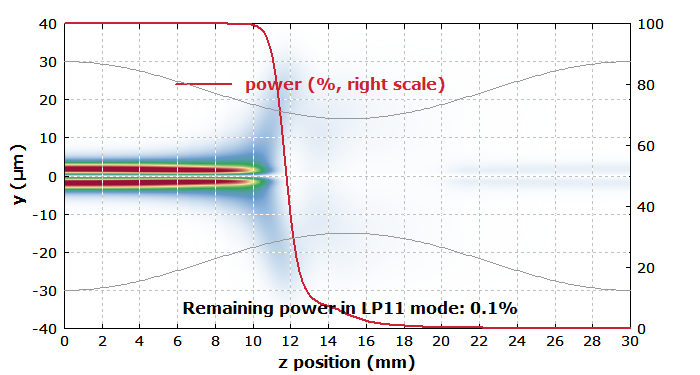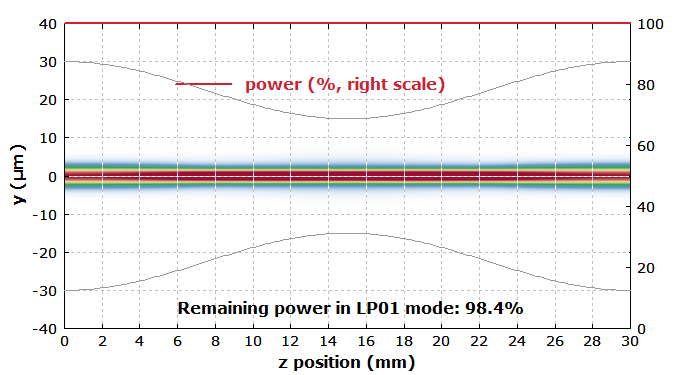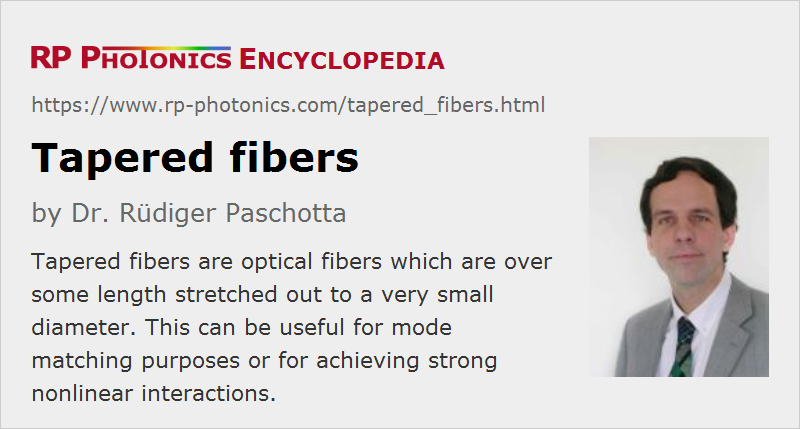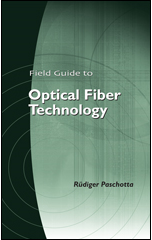Tapered Fibers
Definition: optical fibers which are over some length stretched out to a very small diameter
German: sich verjüngende Faser
Category: fiber optics and waveguides
How to cite the article; suggest additional literature
Author: Dr. Rüdiger Paschotta
A tapered fiber can be produced by gently stretching an optical fiber while it is heated e.g. over a flame, such that the glass becomes soft. This procedure makes the fiber thinner over some length of e.g. a few millimeters or centimeters. The fiber core also gets thinner by the same factor as the total fiber.
Tapers for Mode Matching
Moderate tapers are sometimes used for the purpose of mode matching: it is possible, e.g., to reduce the mode area for one end of a standard single-mode fiber in order to achieve an improved coupling to some small-area waveguide (→ mode field converters).
Tapers for Mode Filtering
Another application is mode filtering: the higher-order guided modes become quite weakly guided or disappear completely in a moderately stretched fiber region, so that largely only light in the fundamental fiber mode remains. Figure 1 shows how light in the LP11 mode is completely lost in the tapered region, whereas light in the fundamental mode (see Figure 2) hardly experiences any losses and even does not undergo a substantial change of mode size (for the chosen parameters).


Strongly Tapered Fibers
It is also possible to perform stronger tapering, as shown in Figure 3, where the diameter of the tapered fiber region can be only a few microns over a length of a few centimeters (or even longer than 10 cm). Under these conditions, the original fiber core becomes so small that it has no significant influence any more, and the light is guided only by the air–glass interface. Provided that the transition regions from the full fiber diameter to the small waist and back again are sufficiently smooth, essentially all the launched light can propagate in the taper region and (more surprisingly) find its way back into the core of the subsequent full-size fiber region.

It has been demonstrated that with somewhat refined tapering techniques (involving indirect heating of the glass via a sapphire taper or a sapphire capillary) it is possible to carry out even very extreme tapering, leading to nanofibers with diameters of a few hundred nanometers or sometimes even well below 100 nm.
Fiber Couplers
If two or more fibers are heated over a flame, they may form a common taper region. That configuration is often used in fiber couplers. Here, some of the light launched into one fiber can couple over to the other fiber, but only into a mode with the same propagation direction – it is a directional coupler.
If the parameters of the original fibers are somewhat different, a null coupler may result, where light launched into one fiber will emerge only from the corresponding end, and coupling occurs only e.g. under the influence of a sound wave propagating in the taper region.
Other Applications
Tapered fibers with few-micron taper regions are interesting for a number of applications, such as supercontinuum generation, fiber-optic sensors, or acousto-optic fiber modulators.
Multi-fiber Tapers
Instead of single fibers, one can also taper fiber-optic plates containing many, sometimes even millions of fibers. Such fiber-optic tapers are mainly used for imaging applications where some amount of (de)magnification is required.
Suppliers
The RP Photonics Buyer's Guide contains 13 suppliers for tapered fibers.
Questions and Comments from Users
Here you can submit questions and comments. As far as they get accepted by the author, they will appear above this paragraph together with the author’s answer. The author will decide on acceptance based on certain criteria. Essentially, the issue must be of sufficiently broad interest.
Please do not enter personal data here; we would otherwise delete it soon. (See also our privacy declaration.) If you wish to receive personal feedback or consultancy from the author, please contact him e.g. via e-mail.
By submitting the information, you give your consent to the potential publication of your inputs on our website according to our rules. (If you later retract your consent, we will delete those inputs.) As your inputs are first reviewed by the author, they may be published with some delay.
Bibliography
| [1] | T. A. Birks and Y. W. Li, “The shape of fiber tapers”, IEEE J. Lightwave Technol. 10 (4), 432 (1992), doi:10.1109/50.134196 |
| [2] | T. A. Birks et al., “The acousto-optic effect in single-mode fiber tapers and couplers”, IEEE J. Lightwave Technol. 14 (11), 2519 (1996), doi:10.1109/50.548150 |
| [3] | C. E. Chryssou, “Theoretical analysis of tapering fused silica optical fibers using a carbon dioxide laser”, Proc. SPIE 38 (10), 1645 (1999), doi:10.1117/1.602271 |
| [4] | T. A. Birks et al., “Supercontinuum generation in tapered fibers”, Opt. Lett. 25 (19), 1415 (2000), doi:10.1364/OL.25.001415 |
| [5] | G. Brambilla et al., “Ultra-low-loss optical fiber nanotapers”, Opt. Express 12 (10), 2258 (2004), doi:10.1364/OPEX.12.002258 |
| [6] | F. Warken et al., “Ultra-sensitive surface absorption spectroscopy using sub-wavelength diameter optical fibers”, Opt. Express 15 (19), 11952 (2007), doi:10.1364/OE.15.011952 |
| [7] | N. Vukovic et al., “Novel method for the fabrication of long optical fiber tapers”, IEEE Photon. Technol. Lett. 20 (14), 1264 (2008), doi:10.1109/LPT.2008.926037 |
| [8] | A. Kosterin et al., “Tapered fiber bundles for combining high-power diode lasers”, Appl. Opt. 43 (19), 3893 (2004), doi:10.1364/AO.43.003893 |
| [9] | V. Filippov et al., “Highly efficient 750 W tapered double-clad ytterbium fiber laser”, Opt. Express 18 (12), 12499 (2010), doi:10.1364/OE.18.012499 |
| [10] | R. Paschotta, tutorial on "Passive Fiber Optics" |
| [11] | R. Paschotta, case study on a tapered fiber |
See also: fibers, nanofibers, fiber couplers, photonic crystal fibers, supercontinuum generation, mode field converters, fiber-optic tapers
and other articles in the category fiber optics and waveguides
 |




If you like this page, please share the link with your friends and colleagues, e.g. via social media:
These sharing buttons are implemented in a privacy-friendly way!